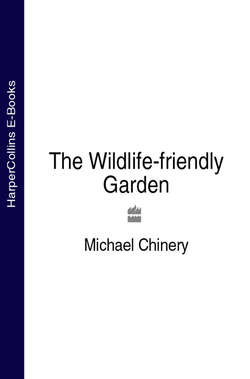Читать книгу The Wildlife-friendly Garden - Michael Chinery - Страница 18
ОглавлениеThe gardens hedge
Most houses come complete with some sort of boundary feature – a hedge or a wall if you are lucky, but more often a relatively barren wooden fence. Although walls and fences can support a limited range of plant and animal life, a mature hedgerow is a thriving community, teeming with insects and other animals. At the same time it can give you privacy and protect your garden from the wind.
You could consider enriching your garden by replacing your fence with a hedge, but only if the neighbours agree! Alternatively, you could plant a low hedge inside your boundary or instal one as the garden equivalent of a room-divider – separating your vegetables from your flower beds perhaps. Hedges are very cheap to create, although they do need more maintenance than walls and fences.
Michael Chinery
The nests of caterpillars of the small eggar moth were once common on roadside hawthorn hedges, but mechanical trimming in summer has caused the species to become rare. Garden hedges may be its salvation.
Michael Chinery
Although it is very conspicuous when viewed on a bare twig, the 10cm (4in) caterpillar of the privet hawkmoth is surprisingly hard to spot in a privet hedge.
What to plant
Although exotic species may bear plenty of tasty berries for the birds, they do not support many insects (see here), so native shrubs are best. Hawthorn is good as it grows quickly, even from cuttings, and it is eaten by more than 150 insect species in Britain alone. Blackthorn, field maple, spindle, dogwood, buckthorn, alder buckthorn and guelder rose are also good. You can encourage honeysuckle, brambles and wild roses to scramble over the hedge. In fact, the more species you can incorporate, the better.
The animal residents
A hedge is both a home and larder for numerous garden animals.
Birds Song thrushes, blackbirds, greenfinches, dunnocks and long-tailed tits all nest in garden hedges. The last two are happy to nest among slender twigs, but the others like to build in a stout fork and are most likely to nest in older hedges. Many more birds find food among the branches.
Mammals Hedgehogs, shrews, mice and voles all forage in the leaf litter at the base of the hedge. Stoats and weasels – Europe’s smallest carnivores – may also hunt there.
Michael Chinery
Rolando Ugolini
The cultivated Prunus shrubs which make up this superb garden hedge are just as good for nesting birds as the wild shrubs.
Insects These abound in the hedgerow and they play a vital role in feeding the local bird population. However, you will need a keen eye to spot the twig-like caterpillars of the geometrid moths, such as the swallowtailed moth and some of the thorn moths. The hairy and colourful caterpillars of the vapourer, grey dagger and yellowtail moths are much easier to find. Most birds will avoid these hairy caterpillars because the hairs of some species can cause severe irritation. Spiders thrive on the insect life, although we tend not to notice these fascinating small garden creatures until the autumn when their webs are more visible (see here).
GARDEN PROJECT – PLANTING A HEDGE FOR WILDLIFE
A hedge is best planted in the winter, and all the plants should be pruned to no more than about 30cm (12in) in height after planting them to encourage the growth of interlocking shoots. Don’t be too eager with your secateurs after that. A hedge does need to be trimmed from time to time, but if you want a really good wildlife hedge then you should do this only once every two years.
By doing this, you will always have some one-year-old wood on which many of the shrubs carry their flowers. It is a good plan to trim half the hedge one winter and the other half the next. Try to keep your hedge narrower at the top than at the bottom; otherwise the ground flora may become shaded out and some of the lower branches may die back and leave gaps.
